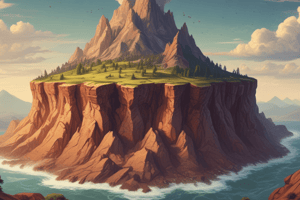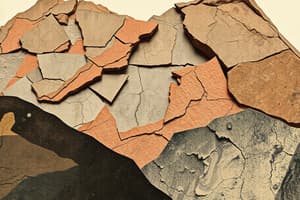Podcast
Questions and Answers
Which metamorphic rock has undergone high-grade metamorphism?
Which metamorphic rock has undergone high-grade metamorphism?
- Slate
- Schist (correct)
- Gneiss (correct)
- Phyllite
What drives metamorphism?
What drives metamorphism?
heat and pressure
What is the process by which new mineral grains larger than the original mineral grains form as a result of metamorphic heat?
What is the process by which new mineral grains larger than the original mineral grains form as a result of metamorphic heat?
Recrystallization
What common metamorphic mineral do clay minerals in sedimentary rock become at temperatures exceeding 200°C?
What common metamorphic mineral do clay minerals in sedimentary rock become at temperatures exceeding 200°C?
What is metamorphic grade?
What is metamorphic grade?
Metamorphic rocks typically look like the preexisting rock from which they form.
Metamorphic rocks typically look like the preexisting rock from which they form.
Which list correctly orders metamorphic rocks from lowest to highest metamorphic grade?
Which list correctly orders metamorphic rocks from lowest to highest metamorphic grade?
What is foliation?
What is foliation?
What kind of texture does a nonfoliated rock have?
What kind of texture does a nonfoliated rock have?
What is the minimum depth at which subduction zone metamorphism will occur?
What is the minimum depth at which subduction zone metamorphism will occur?
Match the following definitions to the terms:
Match the following definitions to the terms:
What are the four agents that drive metamorphism?
What are the four agents that drive metamorphism?
Where is hydrothermal metamorphism common?
Where is hydrothermal metamorphism common?
Which agent of metamorphism can lead to the formation of metallic ore veins?
Which agent of metamorphism can lead to the formation of metallic ore veins?
________ metamorphism will occur where two blocks of rock are grinding against each other.
________ metamorphism will occur where two blocks of rock are grinding against each other.
Flashcards are hidden until you start studying
Study Notes
Metamorphic Textures and Processes
- Metamorphic textures depend on the size and shape of mineral grains, as well as their spatial relationships.
- Textures are categorized into foliated (layered minerals) and nonfoliated (no orientation).
- Low-grade metamorphism retains initial textures, while high-grade metamorphism obliterates them.
- Example: Dark metamorphic rock in Gigapan image is high-grade and shows foliation.
Metamorphism
- Driven by heat and pressure; high heat leads to recrystallization.
- Confining pressure from all directions causes phase changes without folding.
- Differential stress results from pressure mainly in one direction, causing folding (common at convergent plate boundaries).
- Metasomatism changes a rock’s chemical composition through fluid interaction.
Geological Sequence
- Events follow an order: sediment deposition, lithification, metamorphism, and igneous intrusion.
Metamorphic Textures
- Slaty cleavage: Rocks break across layers.
- Schistosity: Exhibits thin, platy mineral layers.
- Gneissic texture: Solid, banded appearance.
Metamorphic Agents and Conditions
- Hydrothermal metamorphism involves hot, ion-rich water.
- Average geothermal gradient in the upper crust is 25°C per km.
- Recrystallization forms larger mineral grains through heat.
Metamorphic Minerals
- Clay minerals at depths exceeding 200°C transform into muscovite.
- Index minerals indicate metamorphic grade based on temperature and pressure.
Foliation and Stress
- Metamorphic grade reflects the extent of parent rock alteration.
- Foliation results from mineral reorientation, typically perpendicular to principal stress direction.
Types and Features of Metamorphism
- Burial metamorphism occurs under low temperature and pressure.
- Regional metamorphism occurs at conditions of 400°C and 5 kilobars.
- Parent rock refers to the original rock that has undergone metamorphism.
Example Metamorphic Rocks
- Sequence by grade: Slate, phyllite, schist, gneiss.
- Blueschist facies indicate high-pressure, low-temperature conditions.
- Gneiss is metamorphosed granite exhibiting foliation.
Chemical and Physical Changes
- Hydrothermal metamorphism is common at mid-ocean ridges.
- Most metamorphic rocks share a similar chemical composition with their parent rocks.
- Marble (calcite) and quartzite (quartz) are both nonfoliated but differ in composition.
Metamorphic Processes and Environments
- Four agents of metamorphism: directional stress, pressure, heat, and chemically active fluids.
- Fault zone metamorphism occurs where rock blocks grind against each other.
- Different metamorphic grades transition from low to high moving towards the Appalachians crystalline core.
Rock Structures and Integrity
- Nonfoliated rocks like marble lack a layered appearance.
- Metamorphic facies indicate mineral assemblages from similar environments.
- Shock metamorphism occurs due to high-speed projectile impact.
Contact Metamorphism
- Produces quartzite, marble, and hornfels near heat sources.
- Subduction zone metamorphism begins at a minimum depth of 13 km.
Preservation of Parent Rock Features
- Low-grade metamorphism allows retention of sedimentary structures and fossils, while higher grades destroy them.
Studying That Suits You
Use AI to generate personalized quizzes and flashcards to suit your learning preferences.




